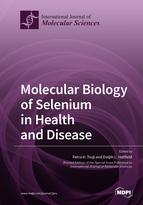Molecular Biology of Selenium in Health and Disease
A special issue of International Journal of Molecular Sciences (ISSN 1422-0067). This special issue belongs to the section "Molecular Pathology, Diagnostics, and Therapeutics".
Deadline for manuscript submissions: closed (15 September 2021) | Viewed by 75088
Special Issue Editors
Interests: Selenium; selenoproteins; dietary micronutrients; trace minerals; inflammation; microbiome
Interests: Selenium; selenoproteins; role of selenium and/or selenoproteins in human health (in cancer prevention and promotion, in suppressing the aging process, in preventing heart disease and in boosting the immune system); immunology; molecular biology
Special Issue Information
Dear Colleagues,
The Editorial Board of IJMS has asked us to edit a Special Issue entitled “Molecular Biology of Selenium in Health and Disease”. The Special Issue will cover many of the most important subjects in the selenium field, including the role of selenium and/or selenoproteins in cancer prevention and promotion, in the aging process, in heart disease prevention, and in boosting the immune system. We, in turn, would like to ask the leaders in the selenium field to write a research article or a summary for this Special Issue with a focus on the role of selenium and/or selenoproteins at the molecular level.
Prof. Dr. Petra A. Tsuji
Dolph L. Hatfield
Guest Editors
Manuscript Submission Information
Manuscripts should be submitted online at www.mdpi.com by registering and logging in to this website. Once you are registered, click here to go to the submission form. Manuscripts can be submitted until the deadline. All submissions that pass pre-check are peer-reviewed. Accepted papers will be published continuously in the journal (as soon as accepted) and will be listed together on the special issue website. Research articles, review articles as well as short communications are invited. For planned papers, a title and short abstract (about 100 words) can be sent to the Editorial Office for announcement on this website.
Submitted manuscripts should not have been published previously, nor be under consideration for publication elsewhere (except conference proceedings papers). All manuscripts are thoroughly refereed through a single-blind peer-review process. A guide for authors and other relevant information for submission of manuscripts is available on the Instructions for Authors page. International Journal of Molecular Sciences is an international peer-reviewed open access semimonthly journal published by MDPI.
Please visit the Instructions for Authors page before submitting a manuscript. There is an Article Processing Charge (APC) for publication in this open access journal. For details about the APC please see here. Submitted papers should be well formatted and use good English. Authors may use MDPI's English editing service prior to publication or during author revisions.
Keywords
- selenium
- selenoproteins
- selenium in human and animal health
- selenium in cancer promotion and prevention
- selenium in inflammation
- selenium in immunology







